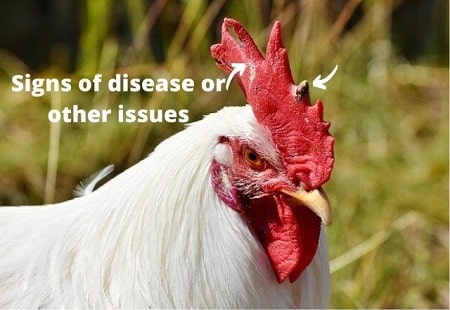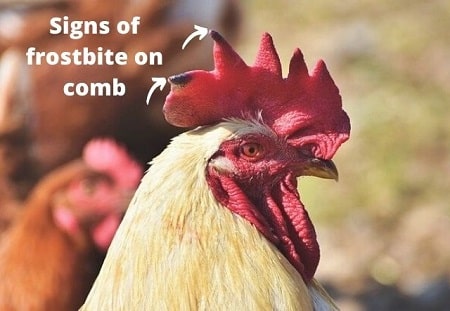Noticed a chicken comb turning black in your flock? The color and health of a chicken’s comb is a good indicator of their general health. If you see black spots or anything else out of the norm, you need to address it asap.
Here are some of the viruses and other health issues that can cause a chicken’s comb or wattles to change color:
Table of Contents
Diseases That Cause Black and Purple Comb Disfiguration in Chickens

Fowl Pox
Fowl pox is a slow-spreading viral infection that is often first identified by black spots on a chicken’s comb.
There are wet and dry forms of fowl pox. The dry form is characterized by small lesions on the skin that progress to black scabs.
The wet form is different, it is characterized by breathing difficulties and you’ll see plaques in the upper respiratory tract and mouth of the chicken.
It’s a particularly difficult virus to prevent as chickens can become infected through skin abrasions, by ingesting scabs from infected chooks, and through respiratory transfer.
The virus can be carried and transmitted by other birds, insects like mosquitoes, and via objects. Its slow-moving nature means you can be dealing with fowl pox within a flock for months.
There is no known cure for fowl pox. Preventative vaccination while replacing chickens is the only way to cycle the virus out of a flock (source).
Related content - Want to learn more about combs and wattles? Check out - what's that red thing on a chickens head?
Fowl Cholera
Fowl Cholera is a highly contagious disease that is often first identified by purple spots on a chicken’s comb or wattle. Along with green diarrhea, coughing, swollen joints, nasal discharge, and some other symptoms.
It’s transmitted between other animals carrying the bacteria, then spread between chickens. Pullets and point-of-lay hens are most at risk, but it can affect chickens of any age.
Fowl Cholera can be treated and prevented through good biosecurity, vaccination, and antibiotics.
It’s not an easy process though. The area will need to be kept free of poultry for weeks while it’s disinfected. Treatment doesn’t always eliminate the virus, it may return when you introduce new birds (source).
Avian Flu (Influenza AI)
Avian flu is another highly contagious viral infection that has caused devastation to the poultry industry in the past.
It’s a lot less common in backyard chicken flocks, but still, it’s something to be aware of.
Symptoms are dark red or black spots on the comb. This indicates a lack of oxygen and poor circulation, often coupled with a respiratory infection, lack of energy, diarrhea, nasal discharge, and other symptoms.
If you suspect AI or have no idea why any number of your chickens have black spots or any of the other symptoms that can be associated with any of these viruses call in a vet asap.
Other Health Issues That Can Cause Black Combs

Frostbite
Frostbite can cause a chicken’s comb and wattle to turn white, typically at the tips where it’s most affected.
This is because frostbite occurs when the fluid in the cells of a chicken’s comb freezes. The extremities are always at greater risk as the blood supply is thinner, hence why it affects the tips.
If you discover a pale comb with white tips, gently warm the area for your chick to help slowly thaw it. In most instances, if caught early they will be perfectly fine.
If their comb is turning purplish or black, this is a sign of severe frostbite. This might be too late to thaw out and return to normal, you should seek the advice of a vet in this instance.
Most of the time, after a frostbitten area has thawed it will swell. You’ll need to protect them from other flock members and nurse them back to full health.
It’s hard to comment on individual birds. You should seek professional medical advice to be on the safe side.
General Poor Health
When a chicken is in poor health their comb will discolor and may even shrivel up. This is because the circulation of blood is reduced, so it can’t keep its vibrant red or rose color.
There are a number of possible reasons for this, so you should always get them checked out by a professional specializing in poultry health.
I’ve known of cases where the chicken was suffering from some kind of heart or liver problems. As a result, their organs were starting to shut down or not function properly, which lowered the blood supply to their extremities.
In Summary
I bet you didn’t know there was so much we can tell about a chicken’s health just by looking at their comb, right?
If you spot a single black spot or patch on your chicken, don’t panic. It’s often the result of a pecking incident or some other small injury.
You should still keep a close eye on them, however. If frostbite is a concern but hasn’t happened yet, a little tip is to put a little vaseline on their comb to help protect their comb.
If you start seeing more spots or a spreading patch of discoloration, that’s when you need to act quickly.
Hopefully, your flock isn’t infected with any of the viruses I covered above, but you should seek professional advice to be sure.




